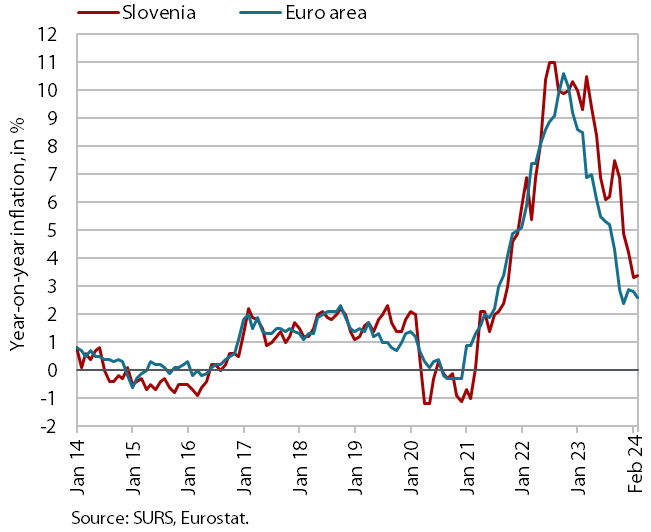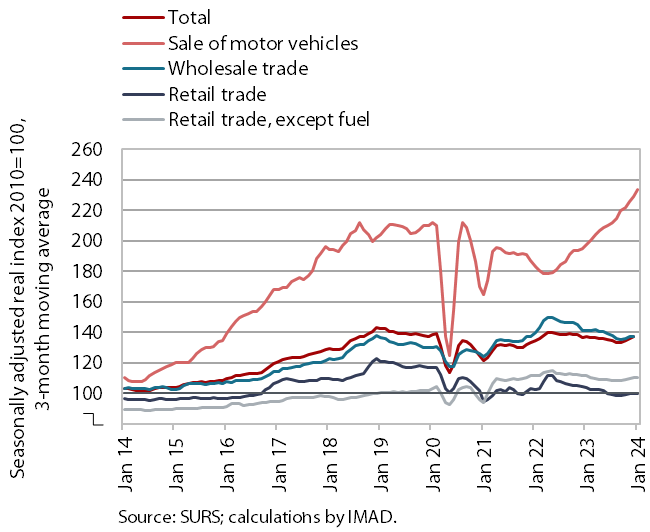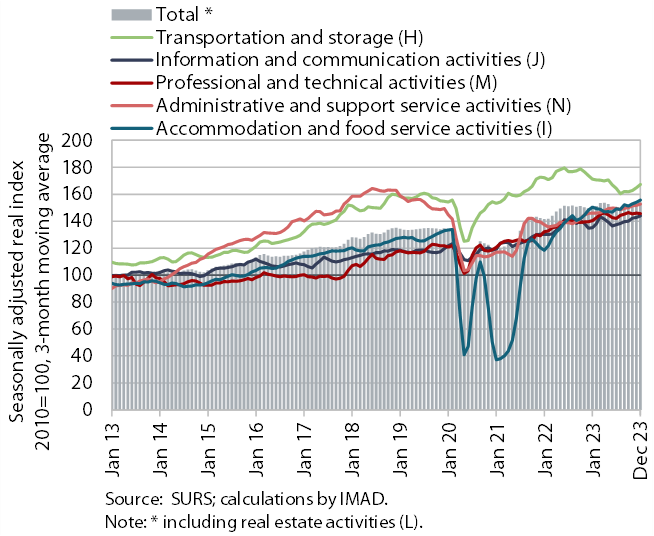Charts of the Week
Charts of the week from 26 February to 1 March 2024:consumer prices, active and inactive population, turnover in trade and other charts
The year-on-year increase in consumer prices rose slightly in February, to 3.4%, mainly due to higher growth in services prices compared to January, but it was around 6 p.p. lower than a year ago. According to the survey data, the number of unemployed people remained unchanged year-on-year in the fourth quarter of last year, while the number of persons in employment was slightly higher due to the upturn in economic activity. Real income in most trade sectors strengthened in the fourth quarter of last year, while year-on-year it was higher in 2023 only in the sales of motor vehicles. Real turnover in market services also increased in the fourth quarter of last year, and in 2023 it was up year-on-year in all services with the exception of transportation and storage.
Consumer prices, February 2024

After falling since October last year, the year-on-year growth in consumer prices accelerated slightly in February, to 3.4%, while it was almost 6 p.p. lower than in the same month last year. Compared to January, there was a slight increase in the contribution from services prices, which were 5.1% higher year-on-year (4.6% in January). Based on the available data, we estimate that the higher growth in services prices is due to stronger growth in the health, restaurants and hotels and housing groups. With a more pronounced seasonal increase, the growth in the prices of package international holidays, which were still lower year-on-year in January, also increased year-on-year (by 14%). Due to slightly different seasonal fluctuations, the contribution from the clothing and footwear group increased. With the higher growth in clothing and footwear prices, the growth in prices of semi-durable goods increased to 3.2%. The year-on-year price increase in the food and non-alcoholic beverages group, which was still at 18.3% in February last year, continues to slow rapidly (2%). The year-on-year decline in the prices of durable goods (by 1.8%) accelerated slightly in February. Prices of petroleum products rose month-on-month due to higher prices on international markets, but their year-on-year decline (0.7%) was slightly more pronounced than in January (0.4%) due to the higher base.
Active and inactive population, Q4 2023

According to the survey data, the number of unemployed remained unchanged year-on-year in the fourth quarter of last year, while the number of people in employment increased. According to original data, 35 thousand persons were unemployed, which is the same as at the end of 2022. The survey unemployment rate (3.4%) was 0.1 p.p. lower year-on-year. With the upturn in economic activity in the fourth quarter of last year, the number of persons in employment increased year-on-year (1.5%). The number of employees in labour relation increased. The volume of student work, the number of unpaid family workers and the number of self-employed remained largely unchanged year-on-year.
The survey unemployment rate averaged 3.7% last year (0.3 p.p. lower than in 2022) and the number of persons in employment rose by 0.3% year-on-year.
Turnover in trade, December 2023–January 2024

In most trade sectors, real turnover rose in the fourth quarter of last year, with only the sale of motor vehicles showing a year-on-year increase; in January, turnover was higher year-on-year also in sale of food and non-food products, according to preliminary data. In the fourth quarter of last year, turnover in the sales of motor vehicles further increased, and this was the only major trade segment in which average turnover in 2023 was higher than in 2022 (by 15%). Turnover in retail sale of non-food products and wholesale trade also increased, although it was still 5% and 6% lower respectively on average in 2023 than in 2022. After an increase in the previous two quarters, retail sales of food, beverages and tobacco fell slightly and was 2% lower year-on-year in 2023 as a whole. According to preliminary SURS data, turnover in January was stronger year-on-year in the sale of motor vehicles and in the retail sale of food and non-food products.
Turnover in market services, December 2023

Real turnover in market services increased in the fourth quarter of 2023 (by 1.2%) after stagnating in the third quarter. Growth was strongest in information and communication activities, where the positive trend has continued since the summer. Growth stemmed from both main sectors – telecommunications and computer services, which generated higher turnover on domestic and foreign markets. Growth was also recorded in the accommodation and food service activities, while growth slowed in professional and technical activities, albeit with a renewed sharp rise in turnover from architectural and engineering services. Following a period of stagnation, turnover growth in administrative and support service activities accelerated, with significant growth in travel agencies and a continued decline in turnover in employment services. After a long period of decline, turnover in transportation and storage increased, particularly due to growth in rail and port traffic. In the last quarter of 2023, total turnover from market services rose by 1.1% year-on-year in real terms and by 1.4% on average in 2023 (only transportation recorded a decline compared to 2022).
